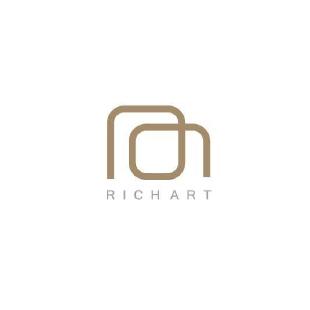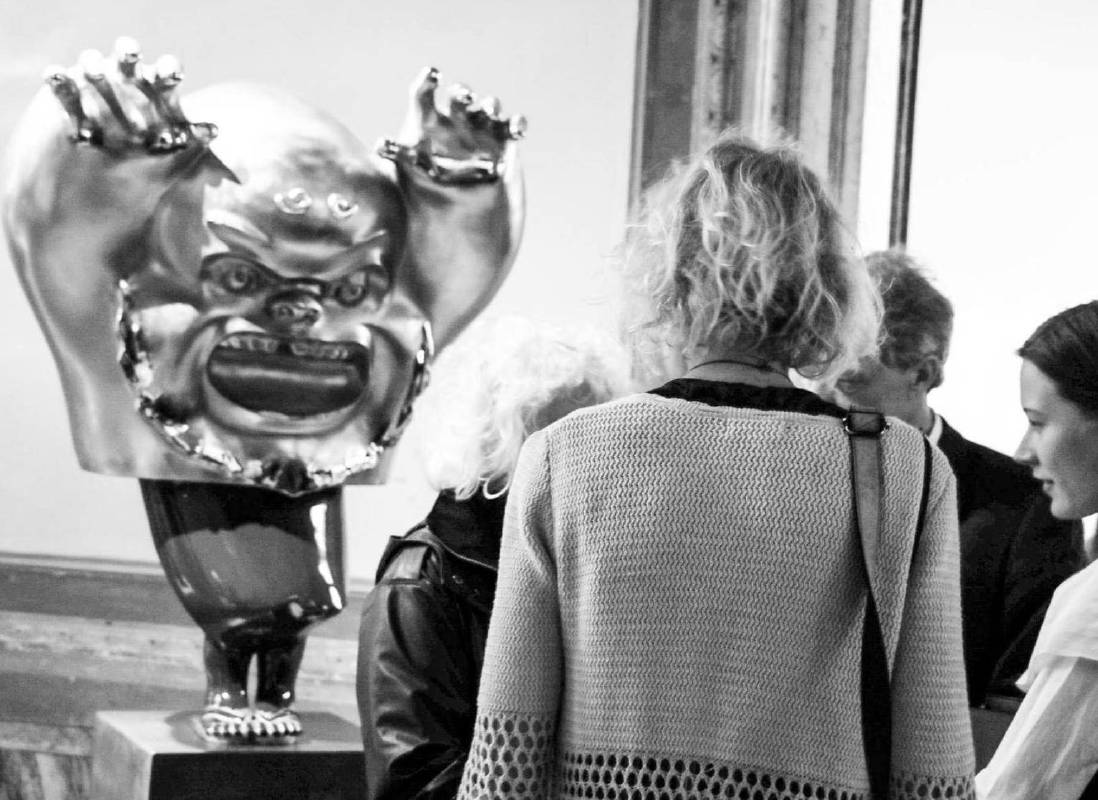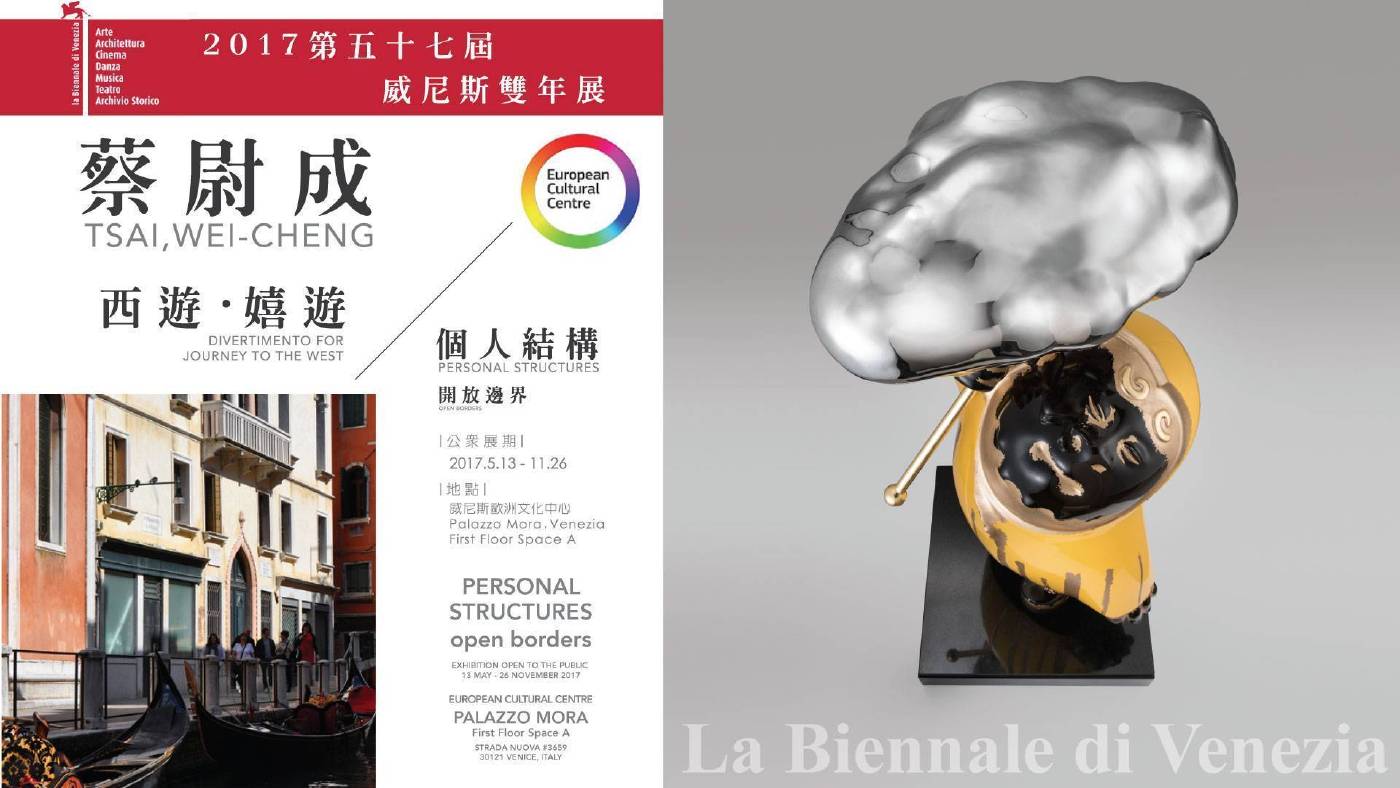大雋藝術 Rich Art:【2017 威尼斯雙年展 蔡尉成|西遊・嬉遊】
2017-04-21|撰文者:大雋藝術
展覽日期:2017/5/13 - 2017/11/26 (5/11 - 12預覽)
Exhibitions Date:May 13 2017 - Nov 26 2017
(Preview 11 - 12 May)
展覽時間:10:00 - 18:00,週二公休
Open: 10:00 - 18:00,Closed on Tuesdays
展覽地點:Palazzo Mora 莫拉宮
Exhibitions Venue:Palazzo Mora / First floor / Space A
主辦單位:歐洲文化中心
Organizer:European Cultural Centre
協辦單位:大雋藝術
Co-organizer:Rich Art
大雋藝術很榮幸受GAA邀請參與策劃2017年威尼斯雙年展,特別推薦並邀請蔡尉成參加2017威尼斯雙年展,對首次參與世界三大展覽之一,且是最負盛名的義大利威尼斯雙年展,蔡尉成以作品「鐵金剛-穿上勇氣 你也能所向無敵」來為首次踏上藝術重鎮鼓舞自己及為理想付諸行動的人。
此次展覽「西遊‧嬉遊」由策展人—徐婉禎博士論述,將蔡尉成作品裡輕快、淺顯及詼諧,卻深刻傳達東方悠遠歷史以來的宇宙觀及人生觀思想遞予西方,來呼應GAA一直以「時間‧空間‧存在」這個主題,喚醒世人對環境與人的關係有進一步討論及思考。
全球藝術事務基金會Global Art Affairs Foundation:全球藝術事務基金會(GAA Foundation)是一個登記在荷蘭,完全由藝術家發起並組織的非營利機構。GAA的宗旨是提昇世人對藝術及藝術相關事務的覺醒及暸解,透過藝術、建築及文化的各類主題,從哲學的角度,更深入的去探討這些主題。從2005年開始,GAA一直以「時間‧空間‧存在」這個主題,邀請世界各地的藝術家、建築師及文化界人士來思考這一主題。
GAA每年透過其旗下的歐洲文化中心在威尼斯雙年展期間参與組織藝術或建築的雙年展。目前,GAA在威尼斯有四個雙年展的官方展場:Palazzo Mora, Palazzo Bembo, Palazzo Michiel 以及 Palazzo Rossini。本次蔡尉成作品將於展場Palazzo Mora展出,歡迎各位嘉賓蒞臨現場參觀。
Rich Art is greatly honored to be invited to participate in the exhibition organized and planned by GAA during Venice Biennale 2017.
They are especially pleased to invite Tsai-Wei-Cheng to attend the exhibition, which is one of the three major exhibitions in the word and it's also the most prestigious Venice Exhibition.
Tsai Wei-Cheng will bring his artwork 『Iron King Kong- Wearing the courage ,you can be invincible.』 the first time he sets foot in the city which encourages people to take action to pursue their ideals.
The exhibition is named "Journey to the West " curated by the curator Dr. Woan-Jen Hsu, She conveys Tsai Wei-Cheng’s works in a brisk, easy to understand and a humorous way.
She profoundly conveys the ancient history of the universe from the cosmological side and outlook on life to the West., in accordance to GAA's theme "time, space, existence" which is meant to evoke the relationship between the environment and people and inspire further discussion and thinking.
Global Art Affairs Foundation: The GAA Foundation is a nonprofit organization that is registered and organized entirely by artists in the Netherlands.
The aim of GAA is to enhance the world's awakening, the understanding of art ,and art related matters. To explore these topics more deeply from a philosophical perspective through the various themes of art, architecture and culture. The foundation was started in 2005,GAA has been using the subject of time, space, existence to invite artists, architects and people from all over the world to contemplate it.
GAA annually participates in organizing Art and Architecture biennales
through its European Cultural Center during the Venice Biennale period. At present, GAA has four official exhibitions in Venice: Palazzo Mora, Palazzo Bembo, Palazzo Michiel and Palazzo Rossini. This time,Tsai wei-cheng’s exhibition will be held at the Palazzo Mora.We welcome you to visit the exhibition.
-----------------------------------------------------------------------------------------------------------------------------------------------------------
西遊‧嬉遊 Divertimento for Journey to the West 文/ 徐婉禎Hsu, Woan-Jen
回溯東西文化的交流,時至今日已歷經久遠,早在大唐貞觀三年(AD629)就有佛教僧人釋玄奘西行求法。玄奘自邊境涼州出關,途經西域諸國、攀越帕米爾高原,最終抵達天竺(印度),歷經十六年後返回到大唐國都長安(AD645)。隨後,玄奘法師翻譯佛教經典七十五部,高達一千三百三十五卷,被譽為中土譯師之最。這些翻譯經典隨著各地而來的遣唐使再傳向朝鮮半島、日本、越南等地,對東方諸國造成宗教信仰上乃至文化藝術上極為深遠的影響。由玄奘法師口述,其弟子辯機執筆撰寫的《大唐西域記》則不但成為日後文學作品《西遊記》的原型,同時也為東西方的歷史地理研究提供彌足珍貴的文獻資料。
成書於十六世紀中葉的《西遊記》,結合儒道釋三教的思想,廣為流傳於世界各地,被翻譯成多種語言的譯本,其故事內容在臺灣更是家喻戶曉,主要在描述唐僧師徒西行取經過程中所遭遇的*八十一劫難。以釋玄奘為發想所形塑的唐僧角色為表面上的主角,然而通篇行文的焦點卻匯聚在其大徒孫悟空的身上。距離《西遊記》成書後約五百年的今日,臺灣藝術家蔡尉成再以其雕塑作品「72系列」將孫悟空帶往西方(威尼斯),實深具跨時代跨文化的意義。
按《西遊記》所述,孫悟空為女媧補天時所遺留下的靈石,靈石吸取自然日月精華,一隻猴子自其中孕育破石而出。道教菩提祖師傳授猴子七十二變幻之法並授予呼喚行動自如的觔斗雲,賜名「孫悟空」。孫悟空所使用的兵器如意金箍棒,是他大鬧龍宮向東海龍王強索而來的;至於他頭戴的緊箍,則是唐僧念咒制約他的法器。對蔡尉成創作「72系列」而言,孫悟空的緊箍代表的是有形乃至無形的規範,提供自由來去的觔斗雲代表的是不受拘束的夢想,可大可小的金箍棒代表的是伸縮自如的力量,而如孩童般的孫悟空形象所代表的則是純真澄澈的自我內在。正是這自我內在的如如不動才映照出外在世界萬事萬物變動的恆常真理,大道化萬物,即《易傳》所云:「易有太極,是生兩儀。兩儀生四象,四象生八卦。」太極是形成宇宙萬物的根源,發動生成世界的運行。陰陽、變與不變,既為相剋亦為相生,互相關連而成為統一體。
蔡尉成「72系列」於威尼斯,讓《西遊記》的孫悟空再次西行,這次的西行不是為了取經,而是為了反饋東方的哲思予西方。〈深吻〉帶有沉浸愛情之中甜甜的詩意;〈鐵金剛〉是自我期許自我勉勵的自我對話,所恐懼者不在於外,而在於內心;〈改天〉描寫人生境遇的陰晴多變,變者,為恆常不變之理。蔡尉成在此以當代藝術語言譜寫孫悟空西遊的嬉遊曲,是那麼輕快、淺顯而詼諧,卻深刻傳達出東方悠遠歷史以來的宇宙觀與人生觀。
Cultural interaction between the East and the West has been going on for a very long time. As early as the 3rd year of Zhenguan in the Tang dynasty (AD629), there was Xuanzang the Buddhist monk going west to seek dharma. Xuanzang exited the border from Liangzhou, going through countries in Western Regions, climbing over the Pamir mountains, and eventually arriving in Tianzhu (now India). It took him 16 years to return to Chang’an, the capital of Tang dynasty (AD645). Afterward, Xuanzang translated 75 Buddhist sutras into 1,335 volumes, and he is regarded as the greatest Buddhist sutra translator in Zhongyuan (the central plain of China). These translated Buddhist sutras were subsequently spread to the Korean Peninsula, Japan, Vietnam, and other places through the diplomatic envoys sent to China by other countries, and the translations had a far-reaching impact on the religions, cultures, and arts of the Eastern countries. Great Tang Records on the Western Regions, narrated by Xuanzang and written by his disciple Bianji, not only became the prototype of the later novel Journey to the West but also provided precious information for historical and geographical research to both the East and the West.
Journey to the West, written in the middle of the 16th century, combined the thoughts of Confucianism, Buddhism, and Taoism and is very popular around the world, having been translated into multiple languages. Its storyline, widely known among Taiwan households, mainly describes 81 disasters that a Tang monk and his disciples went through. The Tang monk, inspired by and modeled after Xuanzang, is the protagonist of the novel on the surface, but the focus of the whole storyline is gathered around his most senior disciple, Sun Wukong. Today, approximately 500 years after the completion of Journey to the West, Taiwanese artist Tsai Wei-Cheng is bringing Sun Wukong west (Venice) again with his 72 Series of sculptural work, a series that has great cross-cultural significance.
According to description of Journey to the West, when Nüwa mended the heavens, she left behind a magic stone. That stone absorbed the natural essences of the sun and the moon, and a monkey later burst out of the stone. Taoist patriarch Bodhi taught that monkey the 72 polymorphic transformations, told it how to summon the somersault cloud, and christened it Sun Wukong. Ruyi Jingu Bang, its weapon, was forcibly obtained from Ao Kuang, the dragon king of the Eastern seas, after Sun Wukong created a mess in the Dragon Palace. The magical headband the monkey wore is the Buddhist instrument that the Tang monk used to contain Sun Wukong by reading spells. In the 72 Series created by Tsai Wei-Cheng, the magical headband of Sun Wukong represents tangible and intangible norms, the somersault cloud that allowed Sun Wukong to go everywhere freely represents unfettered dreams, Ruyi Jingu Bang—the size of which can be enlarged and reduced at will—represents flexible power, and the child-like image of Sun Wukong represents the pure and clear inner self. This immutability of the absolute of the inner self reflects the eternal truth of the ever-changing things in this ever-changing world, namely the fundamental postulate is the great primal beginning of all that exists. That statement is what the I Ching would describe as “There is in the changes the great primal beginning. Taiji generates the two primary forces. The two primary forces generate the four images. The four images generate the eight trigrams”. Taiji is the root of the formation of the universe, driving the earth to rotate. Yin and yang, change and static, are both inter-restricting and yet inter-promoting, interrelated and becoming a unified body.
Tsai Wei-Cheng is bringing his 72 series to Venice and allowing Sun Wukong of Journey to the West to go west again. This trip to the west is no longer about retrieving Buddhist sutras but taking Eastern philosophy to the Western world. Deep kiss has the sweet poetic feel of immersive love. Iron King Kong is the self-dialogue of self-proclamation and self-encouragement; fear does not come from external sources but from inside the heart. The artwork"To Change the fate" describes the circumstances of life that are ever-changing, and change is the eternal truth of life. Tsai Wei-Cheng uses this contemporary art language to compose this divertimento about Sun Wukong going west. The series is brisk, simple, and humorous, yet it profoundly conveys the concept of the universe and life throughout the long history of the Orient.
*八十一是個位數字中最大數九的方乘,在東方以此數字比喻數量之多,多至無限。
81 is the square of 9, the biggest among single-digit numbers, and in the East, it is a metaphor for a very large number that is close to infinite.


